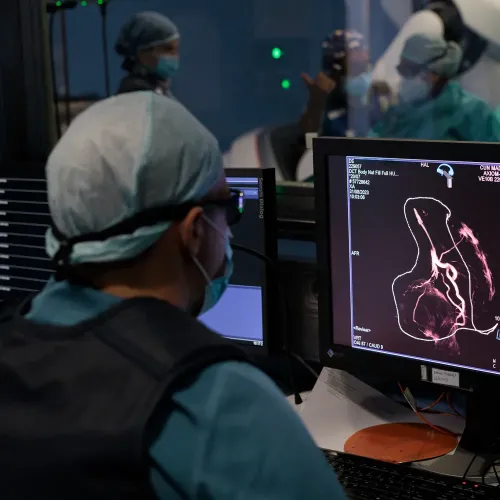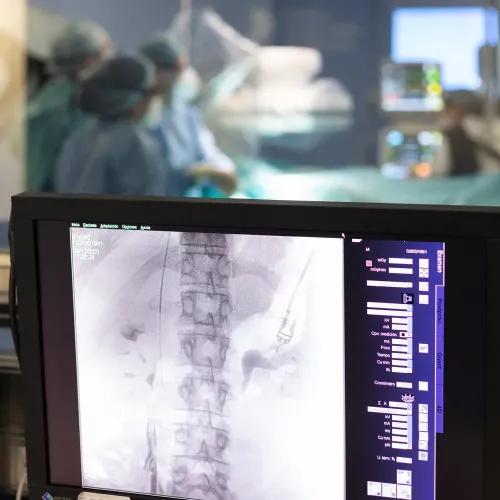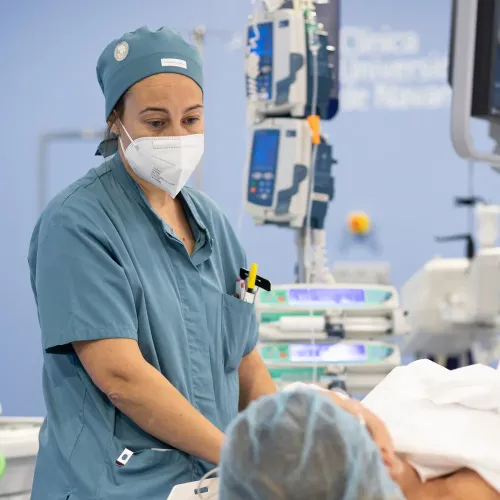Interventional Radiology Unit
"Interventional Radiology offers effective treatments as an alternative to open surgeries, with less discomfort and faster recovery."
DR. ANTONIO MARTÍNEZ SPECIALIST. INTERVENTIONAL RADIOLOGY UNIT
Interventional Radiology is a medical subspecialty that uses advanced imaging techniques —such as fluoroscopy, computed tomography, and ultrasound— to perform diagnostic and therapeutic procedures in a minimally invasive way.
With the help of real-time imaging, specialists insert very fine and precise instruments into the body to treat various diseases without the need for open surgery. Thanks to this precision, procedures such as targeted biopsies, drainages, embolizations, and treatments for vascular diseases or tumors can be performed, among others.
The Interventional Radiology Unit at Clínica Universidad de Navarra is equipped with the most advanced technology and a highly experienced medical team. In addition, it works closely with other departments such as Oncology, Surgery, Urology, Gynecology, Gastroenterology, Pulmonology, Anesthesiology, and Emergency Medicine, ensuring a comprehensive and coordinated approach for each patient, tailored to their specific needs.

A less invasive alternative, more beneficial to the patient

Less
invasiveness
Avoids open surgeries by using small, image-guided punctures

More
security
Reduces risk of complications compared to traditional surgery

Faster
recovery
Reduces pain and allows the patient to return to daily life sooner

Shorter
hospital stay
In many cases, it allows discharge in less time or even on the same day
Specialized units for a better attention
IN NAVARRA AND MADRID
It is based on minimally invasive image-guided techniques to diagnose and treat cancer. These alternatives are less aggressive than conventional surgery, carry a lower risk of complications, and allow for faster recovery in patients.
Percutaneous Tumor Ablation
Tumor ablation consists of precisely destroying cancerous tissue through the application of targeted energy. Using imaging such as ultrasound or Computed Tomography (CT), needles or probes are inserted into the tumor to apply heat (radiofrequency, microwave), extreme cold (cryoablation), or high-intensity electrical currents (electroporation).
These techniques can be used to treat lesions in organs such as the liver, kidney, lung, or bone, and the choice of method depends on the size, number, and location of the tumors.
Intra-arterial Liver Therapies
Intra-arterial therapies deliver treatment directly into the arteries that supply blood to liver tumors, achieving a high concentration of the therapeutic agent in the lesion while reducing toxicity in the rest of the body.
- Chemoembolization (TACE) combines chemotherapy drugs with agents that block the blood flow to the tumor.
- Radioembolization delivers radioactive microspheres that destroy cancer cells from within.
- Arterial embolization limits the blood supply to the tumor, depriving it of nutrients and oxygen.
The choice of technique is tailored to the type of tumor, the extent of the disease, and the patient’s individual characteristics.
Palliative Embolization of Hypervascular Tumors and Tumor Hemorrhages
Palliative embolization consists of deliberately blocking the blood flow to a highly vascularized tumor by injecting specific materials. This technique plays a key role in symptom control:
It reduces the size of tumors that cause pain or discomfort.
It controls acute hemorrhages caused by cancer, which may pose a life-threatening risk.
In this way, it helps improve quality of life and reduce serious complications in advanced stages of the disease.
Image-Guided Biopsies and Pre-surgical Localization
- Image-guided biopsy is an essential procedure in the diagnosis of cancer. Using ultrasound or CT, a sample of suspicious tissue is obtained safely and minimally invasively, allowing for an accurate histological analysis.
- Pre-surgical localization involves placing small visible markers during imaging tests before surgery. These markers allow the surgeon to precisely locate the lesion and ensure complete and accurate tumor removal.
Hepatobiliary intervention focuses on the diagnosis and treatment of diseases affecting the liver, the bile ducts, and the portal venous system. Using minimally invasive image-guided techniques, it addresses complex complications such as portal hypertension (increased pressure in the veins of the liver), obstruction of the bile ducts, or the presence of abscesses and abdominal fluid collections.
TIPS, gastroesophageal varices embolization and portal recanalization
Portal hypertension can cause serious complications such as gastrointestinal bleeding from gastroesophageal varices or excessive accumulation of fluid in the abdomen (ascites).
- TIPS procedure (transjugular intrahepatic portosystemic shunt) creates an artificial channel inside the liver that connects the portal vein with the hepatic veins, lowering portal venous pressure and preventing bleeding.
- Embolization of gastroesophageal varices consists of deliberately occluding dilated vessels to stop active bleeding or reduce the risk of recurrent bleeding.
- Portal recanalization restores blood flow in cases of portal vein thrombosis, preventing complications caused by impaired circulation.
Transhepatic Cholangiography, Biliary Drainage, and Biliary Stents
When the bile ducts are obstructed by stones, tumors, or strictures, bile cannot flow properly, leading to jaundice and a higher risk of severe infections (cholangitis).
- Transhepatic cholangiography allows visualization of the bile ducts with contrast to identify the cause of the obstruction.
- Percutaneous biliary drainage involves placing a catheter through the skin to divert bile either outside the body or into the intestine, relieving symptoms and preventing complications.
- Biliary stents (metallic or plastic prostheses) are inserted into the ducts to keep them open and ensure continuous, long-term drainage.
Drainage of Hepatic or Abdominal Collections and Catheter Placement
Post-surgical complications, infections, or pancreatitis can lead to collections of infected fluid (abscesses) or inflammatory accumulations within the abdomen.
Under ultrasound or CT guidance, drainage catheters are placed in the affected area to safely and precisely evacuate the contents.
These procedures avoid the need for open surgery, reduce the risk of complications, and speed up patient recovery.
In addition, the interventional team provides maintenance, replacement, and removal of the catheters, ensuring proper function and clinical follow-up.
Preoperative Portal Embolization
For patients who are candidates for complex liver surgeries —such as the resection of large primary tumors or metastases— it is essential to ensure that the remaining liver can maintain adequate function after the operation.
Preoperative portal embolization involves selectively occluding the branches of the portal vein that supply the portion of the liver to be removed.
This procedure induces compensatory growth (hypertrophy) of the healthy liver that will remain, increasing surgical safety and reducing the risk of postoperative liver failure.
Through the use of catheters, guidewires, balloons, and stents, it is possible to access virtually any vascular territory in the body through small skin punctures, usually in the groin or arm.
This minimally invasive approach is essential for treating arterial obstructions, stopping severe hemorrhages, repairing aneurysms, or restoring blood flow blocked by clots. All of this is achieved with a safe and effective alternative to traditional open surgery, resulting in fewer complications and faster recovery for patients.
Arteriography, Angioplasty, and Stents in Visceral Territories
Arteriography is a diagnostic procedure that allows visualization of the interior of the arteries by means of contrast injection. When stenosis or obstructions are detected that compromise the irrigation of organs such as the kidneys (cause of arterial hypertension) or the intestine (cause of pain when ingesting food), angioplasty can be performed, which consists of dilating the affected artery by means of a balloon. In many cases, a stent, a small metal mesh that keeps the vessel open and ensures adequate blood flow in the long term, is also implanted.
Acute Hemorrhages
Arterial embolization is an urgent, life-saving technique used to control active bleeding in different parts of the body: gastrointestinal, pulmonary, traumatic, or post-surgical. It consists of navigating a catheter to the exact bleeding site and occluding the affected vessel by injecting specific materials. This fast, minimally invasive procedure allows stabilization of patients in critical situations, especially when surgery is not possible or carries a very high risk.
Visceral Aneurysms and Pseudoaneurysms
Aneurysms are abnormal dilations of the arteries that carry a risk of rupture and severe hemorrhage. Thanks to endovascular techniques, they can be repaired from inside the vessel:
- Filling the aneurysm sac with embolic materials, such as coils, to exclude it from circulation.
- Placing covered stents that reinforce the arterial wall and seal the weakened area.
In this way, open surgery is avoided, reducing risks and promoting a safer, faster recovery.
Catheter-Directed Thrombolysis, Mechanical Thrombectomy, and Stents
These techniques are used when a clot (thrombus) blocks an artery or vein, causing acute ischemia.
Catheter-directed thrombolysis involves delivering fibrinolytic medications directly to the clot to dissolve it.
Mechanical thrombectomy uses specialized devices to physically extract the clot from the vessel.
In many cases, the treatment is combined with angioplasty and stent placement to address the underlying vascular lesion and ensure long-term vessel patency.
Inferior Vena Cava Filters
This procedure consists of placing a filter in the inferior vena cava, the main vein that carries blood from the lower part of the body to the heart. The filter traps clots that may detach from the legs (deep vein thrombosis) before they reach the lungs and cause a pulmonary embolism. It is used in patients at high risk of embolism in whom anticoagulation is contraindicated or ineffective. Both temporary and permanent filters are available, depending on the patient’s clinical needs.
Dialysis Access
The proper function of vascular accesses for hemodialysis (arteriovenous fistulas and grafts) is vital for patients with advanced kidney failure. When these accesses become narrowed or thrombosed, procedures such as angioplasty, stent placement, or thrombectomy are performed to restore blood flow. The goal is to prolong the lifespan of the fistula or graft, ensuring that patients can continue their dialysis treatment under optimal conditions and without interruption.
Interventional Radiology offers minimally invasive solutions for benign conditions specific to women and men that traditionally required surgery. Using catheters and image-guided techniques, it is possible to safely and effectively treat conditions such as uterine fibroids, benign prostatic hyperplasia (BPH), pelvic varicose veins or varicocele, among others.
These procedures, performed through small skin punctures, avoid visible scars, reduce postoperative pain, shorten hospital stays, and allow for a much faster recovery compared to conventional surgery.
Uterine Fibroid and Adenomyosis Embolization
Uterine fibroid embolization is a non-surgical treatment for women with symptomatic fibroids that cause heavy bleeding, pelvic pain, or compression of neighboring organs. It can also be used in cases of adenomyosis, a benign condition of the uterus.
Using a catheter inserted through the femoral or radial artery, the uterine arteries are reached and the blood flow feeding the fibroids is blocked with small embolic particles. By cutting off their blood supply, the fibroids shrink in size and symptoms improve or disappear and reproductive capacity, avoiding hysterectomy.
Pelvic Varices Embolization
Pelvic congestion syndrome is a common cause of heaviness or even chronic pelvic pain in women and is due to dilation of the pelvic or ovarian veins. It is often diagnosed late because it is confused with other gynecological or abdominal conditions.
The procedure consists of inserting a catheter through a vein in the groin or arm, reaching the dilated veins, and sealing them from within using embolic materials. In this way, venous insufficiency is corrected, symptoms improve, and the patient experiences very fast recovery without the need for open surgery.
Prostatic Artery Embolization for BPH
Benign prostatic hyperplasia (BPH) is one of the most common conditions in older men and can cause urinary symptoms such as difficulty urinating, urgency, or increased frequency.
Prostatic artery embolization is a minimally invasive alternative to surgery. Through a microcatheter, the arteries supplying the prostate are selectively occluded. By reducing the blood flow, the gland shrinks in size, relieving obstruction and significantly improving urinary symptoms while preserving sexual function and avoiding surgical complications.
Varicocele Embolization
Varicocele is the dilation of the veins in the scrotum, common in young men, and a frequent cause of testicular pain and male infertility.
Percutaneous embolization allows this condition to be treated without the need for open surgery. Through a catheter, the dilated spermatic vein is accessed and occluded with embolic agents (such as coils or sclerosing substances). This procedure eliminates abnormal venous reflux, improves symptoms, and may enhance fertility, with minimal discomfort and rapid recovery.
Do you need to request a consultation with one of our specialists?
How is the patient process in Interventional Radiology
The patient is the center of our care, guaranteeing maximum safety, comfort and well-being at every stage

Before the procedure
Evaluation and Informed Consultation
Your doctor will review your medical history and explain the procedure in detail. Feel free to ask any questions you may have, and sign the informed consent once you feel ready.
Preparation: Fasting and Medications
For your safety, it is necessary not to eat or drink anything in the hours prior to the procedure. A general fasting period of 4 to 6 hours is recommended.
Depending on the type of procedure and your health status, you may be given some medication before starting. Always follow the instructions provided by the medical and nursing team.
If you are taking blood-thinning medications such as Sintrom®, or antiplatelet agents such as Adiro® or Plavix®, it is essential that you inform us so they can be suspended or adjusted several days before the procedure to reduce the risk of bleeding during and after the intervention.

During the Procedure
Our goal is to make your experience as comfortable and safe as possible. To achieve this, the entire interventional radiology team —including physicians, nurses, and technicians— will work in a coordinated manner, paying close attention to every detail and taking care of you at all times.
Sedation and Analgesia
To ensure your comfort and avoid discomfort, most procedures are performed under conscious sedation and local anesthesia at the puncture site. With this type of sedation, you remain relaxed but awake, allowing communication with the team at all times.
Throughout the procedure, your vital signs (pulse, blood pressure, oxygen saturation) will be continuously monitored to ensure maximum safety.
Average Duration
Although each case is different, the vast majority of interventional radiology procedures have an average duration ranging from 30 minutes to 2 hours. The medical team will always inform you of the estimated time for your specific procedure, adapted to your clinical situation.
Same-Day Discharge or Short Hospital Stay
One of the main advantages of these minimally invasive techniques is the rapid recovery they provide compared to open surgery.
In most cases, patients can be discharged the same day, after a short observation period in the recovery room to ensure everything is fine and to monitor the puncture site.
In more complex procedures, a short hospital stay may be necessary, usually around 24 hours, to provide closer monitoring before final discharge.

After the procedure
Care does not end when the procedure is finished. Follow-up is essential to ensure a complete recovery and to detect any issues in time.
Post-Discharge Care
When you return home, you will receive clear written instructions. In general, it is recommended to have relative rest during the first 24–48 hours, monitor the puncture site for possible bruising or bleeding, and maintain adequate hydration. It is essential to follow all instructions to prevent complications.
Warning Signs
Contact our team or go to the Emergency Department if you experience:
- Severe pain that does not improve with the prescribed pain medication.
- Significant bleeding or swelling at the puncture site.
- Fever or any other symptom that concerns you.
Team Follow-Up
Our commitment to you continues after discharge. We will schedule a follow-up, which may be by phone or in an in-person consultation, to assess your recovery, review the results of the procedure, and address any questions you may have.
For us, it is essential to ensure that the care you received has been optimal and has met your expectations.
Our team of professionals
TECHNOLOGY
Hybrid operating rooms
We have the best diagnostic imaging technology and state-of-the-art image-guided surgery, especially indicated for angiography and minimally invasive vascular interventions.
Ultrasound with image fusion
The ultrasound scanner with image fusion allows real-time combination of ultrasound images with other imaging modalities (CT, MRI, PET) facilitating biopsy and ablation procedures.



